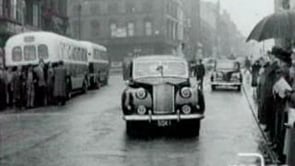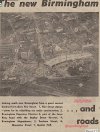I quote Norman Tiptaft writing in the last months of the war:
At present the number of private motorcars is considerably restricted. Those restrictions will not continue when manufacturers are able to produce new ones. With a higher standard of living which has obtained during the war period, and which may quite well continue for a time afterwards, the demand for cars is likely to be far beyond the capacity of our present roads to carry. That will involve considerable replanning in the centre of the city.
The Public Works Committee has decided that most of the problems can be met by the construction of an inner ring road, which will encircle the city at a point approximately not more than half a mile from New Street Station. It is suggested that this road should have a width of at least 110 feet, should be constructed with appropriate carriage ways, adequate footpaths and have facilities for omnibus loading stations along its entire length. It will run from the junction of Great Charles Street and Snow Hill, via Snow Hill to Corporation Place, Stafford Street, Moor Street, at a point below Carrs Lane, be carried to the junction of High Street and New Street, and on to Worcester Street, Smallbrook Street, Suffolk Street – connecting at the other end of Great Charles Street near the Hall of Memory. Colmore Row will be widened to at least 80 feet, and will probably form the chief omnibus loading place of the city centre.
It is considered essential that New Street and Corporation Street should be free, both from through traffic and public service vehicles, because their main purpose is shopping. Shopping streets do not require wide carriageways although the footpaths may need to be wider than at present. The small factories in the neighbourhood of Snow Hill will eventually disappear, and the shopping and business area will spread outwards, at least to the new ring road. At present the shopping area in Birmingham is too small, and an extension appears desirable.
If the local authority could start replanning from the ground up, it would be a simpler problem, but it has to take account of existing conditions. A patchwork solution is not worthwhile, but reconstruction cannot be easy as when building an entirely new city. The construction of an inner ring road, plus some street widening, will – it is thought – solve most of Birmingham's central traffic problems for the immediate future. Most of the main arteries leading to the city will have to be increased in width.
Unfortunately, while submitting a bold and comprehensive scheme, neither the Public Works Committee nor the Council knows at present how the bill is to be paid.....
........ One necessary condition of lessening traffic intensity is taking cars off the road, where they would otherwise be standing, and transferring them to car parks. A scheme has already been approved for a car park holding from 1200 to 1500 vehicles, underneath the gardens of the future Civic Centre at Broad Street, while two others are suggested, one in Digbeth and one adjoining Snow Hill.
Those more knowledgeable than I about the current city will tell us whether this is precisely what happened. Or not.
The one thing I do remember about the city in the war years was the wide dual carriageways (and how modern and forward thinking they looked) with their centre reservation occupied by the trams. And especially the evidence that work in some places had stopped suddenly and might, conceivably, have to await a time in the inconceivably distant future when work could be resumed - if ever. An example of this I knew well was the Kingstanding Road between Perry Barr and Kingstanding which started off as single carriageway before diving off to the left into the section where the full dual carriageway had been completed by 1939. All signs of the farsightedness which the Council seems to have had very early on about the future of the motor car and its demands.
Chris
(Source: "I Saw a City" by Norman Tiptaft - 1945)

 www.macearchive.org
www.macearchive.org










